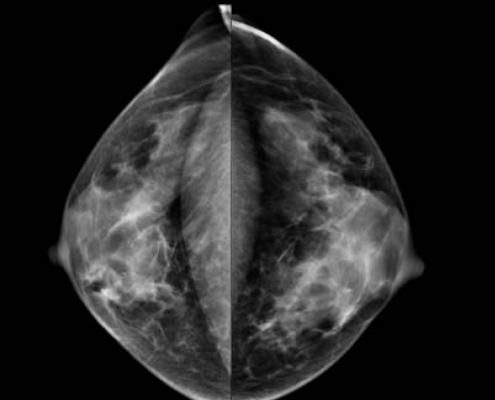
October 5, 2016 — The American College of Radiology (ACR) announced in a recent statement that if Congress does not act, millions of women may lose insurance coverage for annual mammograms. Patient groups, minority healthcare advocates and breast cancer experts are urging Congress to extend a federal mandate that effectively requires insurers to fully cover annual screening mammograms for women ages 40 and older.
“For many women, a loss of insurance coverage for mammography effectively denies them access to a tool that could save their lives. Congress can’t let this happen,” said Sarah Storey, president of Bright Pink, a national non-profit organization focused on the prevention and early detection of breast and ovarian cancer in young women.
"Black women have a higher incidence of breast cancer before age 40. They are also 42 percent more likely to die from the disease. Early prevention is key! Without this mandate, black women's lives are at risk," said Linda Goler Blount, president and chief executive officer of the Black Women's Health Imperative.
“We don’t want to see a day where women are not covered for mammograms until age 50 and then only every other year. If we do, late-stage breast cancer diagnoses will rise and breast cancer deaths will increase,” said Carolyn Aldigé, president and founder of the Prevent Cancer Foundation.
Due to end Dec. 31, 2017, a federal statute bars insurers from basing coverage decisions on recent U.S. Preventive Services Task Force (USPSTF) breast cancer screening recommendations. In 2016, the USPSTF advised against routine screening in women for 40-49 and 74 and older. The Task Force encouraged only biennial screening for those 50-74. These guidelines conflict with those of every major medical association expert in breast cancer care.
“Detecting breast cancer early with a mammogram saves lives and enables less extensive treatment, which preserves quality of life for women and families. Congress must protect insured-access to mammography,” said Marc Heyison, president and founder of Men Against Breast Cancer.
The statute empowers insurers to consider 2002 USPSTF recommendations for regular screening in women 40 and older. Although not included in the recently passed, and narrowly focused, continuing resolution to fund the government through Dec. 9, 2016, an extension of this mandate is included in larger appropriations legislation under consideration on Capitol Hill. The patient and medical groups want Congress to ensure that moratorium is included in the final version of this legislation.
“Early detection of breast cancer with mammography is key to surviving this deadly disease. Insurance coverage often equals access to care. Congress must protect that access,” said Jean A. Sachs, MSS, MLSP, chief executive officer of Living Beyond Breast Cancer.
The American Congress of Obstetricians and Gynecologists (ACOG), National Comprehensive Cancer Network, Society for Breast Imaging (SBI) and the ACR recommend that women start getting annual mammograms at age 40. The USPSTF, American Cancer Society, ACR and SBI agree that the most lives are saved when women start getting annual mammograms at 40 versus delayed or less frequent screening.
“Hereditary cancers tend to occur at an earlier age, and like many other cancers, can be more aggressive in women in their 40s and younger. Lives will be lost if we don’t act to assure continued insurance coverage of annual mammography for women in their 40s,” said Sue Friedman, executive director of FORCE: Facing Our Risk of Cancer Empowered.
“Women in their 40s often have dense breasts – increasing their odds of developing breast cancer. These women must have insured access to mammography and the opportunity to discuss with their doctor whether additional testing is right for them,” said JoAnn Pushkin, executive director of DenseBreast-info.org.
According to National Cancer Institute data, since mammography screening became widespread in the mid-1980s, the U.S. breast cancer death rate, unchanged for the previous 50 years, has dropped by more than a third.
“If Congress allows mandatory mammography insurance coverage to lapse for women 40 and older, many won’t be able to afford to get mammograms. Screening rates will drop. More women will die and the gains we have made against breast cancer may evaporate,” said Debra Monticciolo, M.D., FACR, chair of the ACR Breast Imaging Commission.
“Annual mammography use cuts a woman’s risk of dying from breast cancer nearly in half. That is a tremendous step forward in breast cancer care that should not be cast aside. Lawmakers must ensure that women retain coverage for this lifesaving exam,” said Elizabeth Morris, M.D., FACR, FSBI, president of the Society of Breast Imaging.
“The lack of access caused by reduced insurance coverage may result in unnecessary deaths and women enduring far more extensive treatments for cancers that could have been found earlier by a mammogram. Congress can avert this by continuing mandatory insurance coverage for annual mammograms,” said Kimberly Samuels-Bolin, BS, RT (R)(M), ARRT, ARDMS, executive director of the National Consortium of Breast Centers.
The Affordable Care Act (ACA) requires private insurers to cover exams/procedures given a grade of “A” or “B” by the USPSTF with no copay. Medicare determines coverage separately. The Task Force gave routine screening of women ages 40-49 a grade of “C” and gave a “B” grade only to biennial screening for women 50-74. Thus, women 40-49 who want to get a mammogram and those 50-74 who prefer annual screening may not be guaranteed coverage under the ACA if these USPSTF recommendations became policy. The moratorium on these recommendations, included in the Consolidated Appropriations Act (Sec. 229), effectively requires insurers to cover mammograms with no copay.
For more information: www.mammographysaveslives.org, www.radiologyinfo.org, www.sbi-online.org


 April 16, 2024
April 16, 2024 








